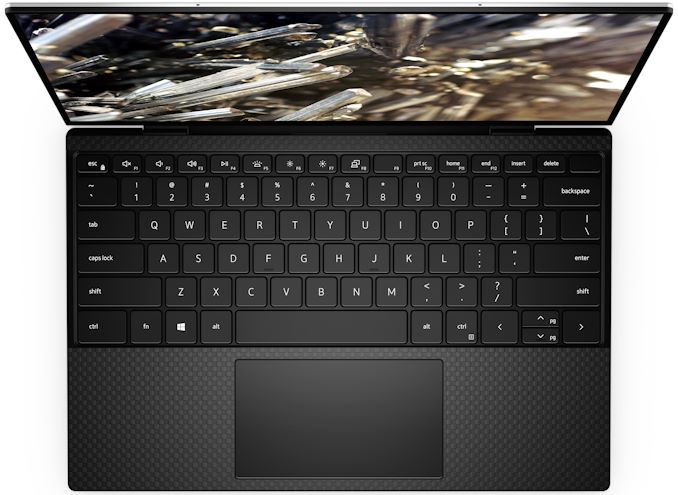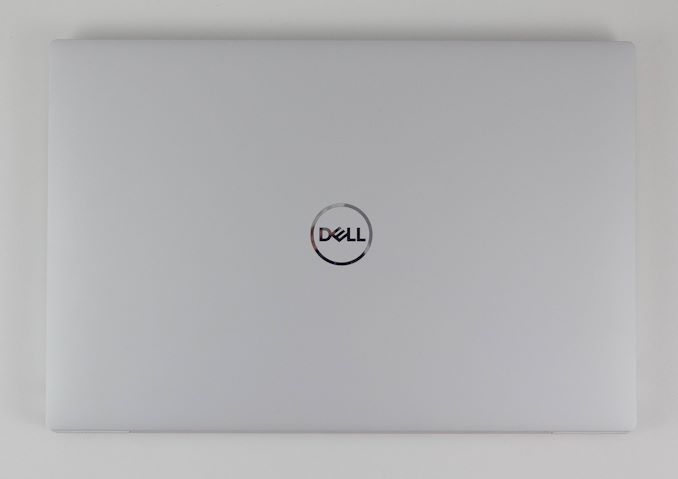The Dell XPS 13 (9300) Review: Return of the King
by Brett Howse on July 16, 2020 10:00 AM ESTDesign
Dell pioneered the thin-bezel laptop, but that does not mean they did not have room to improve on their original design over the years. The first several generations featured a webcam at the bottom of the panel, which was flattering to no one. With the proliferation of video chat, such a decision would be a major negative to many people. But thankfully Dell solved that particular issue a couple of generations ago, and the new model continues to pack a 720p webcam in the correct location above the display, with only a slightly taller top display bezel to accommodate the camera. And speaking of the display bezel, Dell has tweaked their design language slightly over the XPS 13 2-in-1, with both the black and white models both featuring a black display bezel on the clamshell XPS 13, which helps it disappear into the background a bit easier than the white bezel on the 2-in-1.

The XPS 13 in Platinum Silver with black carbon fiber
Another nice change over the 2-in-1 version is that Dell is not using their MagLev keyboard design, instead outfitting the XPS 13 with a more traditional scissor-switch keyboard with 1.0 mm of travel. The MagLev has a very short throw, whereas I find the traditional keyboard to be much more reassuring to use.
Dell is offering the XPS 13 in the same color choices as the 2-in-1 as well. The Platinum Silver model features a black carbon fiber keyboard deck with a soft-touch coating, while the Arctic White model features a woven fiber keyboard deck which Dell has treated with a stain and UV resistant coating, to prevent the deck from yellowing with age. The Arctic White is only $49 more, and certainly makes a statement, although it still suffers from the same issue as all white-on-white laptops with white backlighting, which is that the keyboard backlighting can wash out the keys in a bright room. That is a fairly minor negative though, for an otherwise fantastic finish.
The XPS 13 also features an excellent trackpad, offering a very smooth finish, and good precision. Laptop trackpads have come a long way, and part of that is the standardization on the Microsoft Precision touchpad drivers, which Dell employs here.
Dell has eschewed the use of USB Type-A ports, instead offering just a single USB Type-C port on each side of the laptop. This in turn is paired with a 3.5 mm headset jack on the right, and a micro SD card reader on the left. Although the XPS 13 lacks ports in numbers, it somewhat makes up for that with both USB ports supporting Thunderbolt 3, including power delivery. It is unfortunate that the Type-C port has found itself to be so confusing in its capabilities, but with the XPS 13 supporting the full range of protocols, as well as four lanes of PCIe on both ports, that at least is not a liability here. Dell does include a Type-C to Type-A adapter in the box as well, for those that require the larger port. By including power delivery on both sides of the laptop, that also means the XPS 13 can charge on either side, which can be very handy when moving the laptop from place to place.
Dell’s design ethos with their XPS lineup has converged across the entire range of XPS laptops, and with great success. The CNC milled aluminum bodies, thin bezels, compact designs, and lightweight chassis make for some of the most compelling devices in the industry. Moving to a 16:10 aspect ration on their XPS line has been yet another design win for Dell, and helps provide the excellent 91.5% screen to body ratio found on this XPS 13 notebook by further shrinking the bottom bezel. Dell has sculpted a clean, sleek, and functional device, and while the rest of the industry has also adopted the thin-bezel design, Dell has really mastered it.













224 Comments
View All Comments
Erulian - Thursday, July 16, 2020 - link
My received 2 in 1 has many parts that did not fit well. For example, the screen's topmost layer bulges out at the bottom of the frame, and a few keys are poorly stabilized. The hinge is also too stiff, making opening the laptop a two-handed job. I wonder if I got an early production version as a result of the rush to get units out to customers. The OS install also feels stuttery at times. Since these issues do not impact normal use, I've so far not bothered with informing Dell.iq100 - Thursday, July 16, 2020 - link
When the XPS 15 9560 was purchased with on site service, it took six attempts to get it to work.Here are the parts replaced on just the last (sixth) attempt.
SERVICE REPORT
REPLACEMENT PARTS
No. Dell Part QTY Description Parts Retained by Customer
1 5R1JP 1 ASSY,CVR,BTM,W/BDG,9550 No
2 M0T6P 1 ASSY,PLMRST,W/FPR,80,9560 No
3 9TXK7 1 ADPT,AC,130W,DLTA,4.5,L6,V2,E5 No
4 RN699 1 ADPT,CON,VID,DNGL,DP2VGA,L No
5 64TM0 1 ASSY,CBL,DC-IN, 9550/5510 No
6 2JVNJ 1 CORD,PWR,125V,2.5A,1M,C5,E5,US No
7 5G0HC 1 ASSY,PWA,DTRBD,AUDIO,9560/5520 No
Old wounds, not healed only fester. I purchase two U3011s. Both suffered the same design defect. Dell replace one but NOT the other, claiming "it was their policy to replace only one". Go figure.
www.tinyurl.com/HellIsDell
grant3 - Friday, July 17, 2020 - link
You're making me feel better... The xps-15-7500 6 weeks ago hasn't seen a day of use yet because of the massive delays in getting the touchpad + fingerprint defects fixed.I'm surprised the hardware is never tested on new machines before being shipped.
ET - Thursday, July 16, 2020 - link
My XPS 13 9350 definitely could use an upgrade, but I'd rather have a Ryzen in my laptop.eastcoast_pete - Thursday, July 16, 2020 - link
Looks nice, just one major downside, and one "wish they'd made that available": the major downside is the complete absence of a USB type A connector. I know they include an adapter, but that's just one more thing to forget or lose. If a Surface tablet has enough space for one, the XPS should have space for one, too. 2 USB-C/TB + one USB A 3.2, and it'd be almost perfect. The other "complaint" is the battery size. I'd gladly pay a bit extra and lug another 200 g around and have a 90 Wh battery - now that'll be a "whole day without recharge" ultraportable.And yes, it would have been nice to have a 4800u as a processor option, but these units are designed over a year before rollout, and AMD wasn't all that ready to rumble last summer. Now they are, and I hope that Dell will add a Renoir option for their 2021 XPS models.
eastcoast_pete - Thursday, July 16, 2020 - link
Forgot to add: why only one (one!) heatpipe with a 42 W top TDP CPU? C'mon, Dell, add the 50 or 100g weight for a second heatpipe and give the thing the cooling it deserves!Deicidium369 - Thursday, July 16, 2020 - link
and will be going against the massively superior Tiger Lake - MX350 level graphics, and 17% slower with half the cores (4 vs 8) than the top end Renoir. Unlikely to ever see an AMD in an XPS13 class machine.tamsysmm - Friday, July 17, 2020 - link
Yeah right, Renoir is such a failure. Only these cheap and low quality models available (ThinkPad X13 13” (AMD) Laptop, LENOVO ThinkPad T14s AMD Ryzen 7 Pro 4750U, HP Elitebook 835/845/855 G7). Oh wait...Korguz - Friday, July 17, 2020 - link
to Deicidium369, ANYTHING AMD makes is a failure.Spunjji - Friday, July 17, 2020 - link
I just don't buy this "AMD weren't ready" shtick. Asus designed an *entirely new class of gaming laptop* around Renoir. It really wouldn't have been difficult for Dell to integrate Renoir into this design - which has released much later in the year than the Zephyrus 14 - if they had had any interest in doing so.Whether this is down to AMD's failure in OEM outreach, Dell's failure in imagination, or standard Intel shenanigans is unclear - but the end result is inferior products and TBH I'm sick of it.